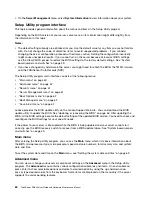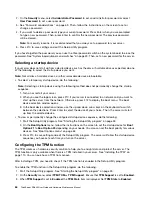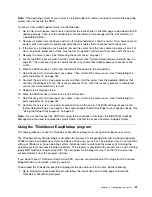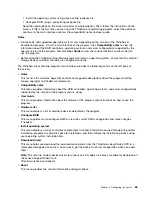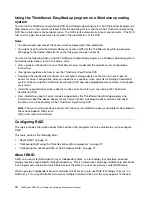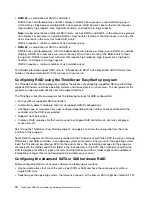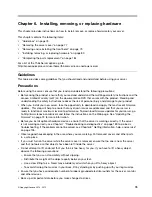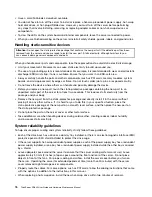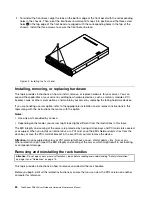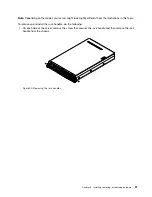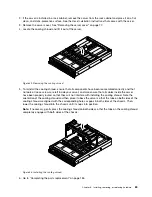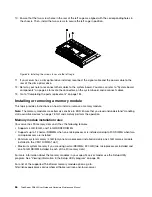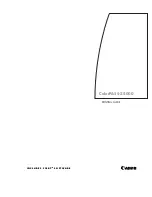
•
RAID 50
: a combination of RAID 0 and RAID 5
RAID 50 uses distributed parity and disk striping. A RAID 50 drive group is a spanned drive group in
which data is striped across multiple RAID 5 drive groups. RAID 50 works best with data that requires
high reliability, high request rates, high data transfers, and medium-to-large capacity.
Note:
Having virtual drives of different RAID levels, such as RAID 0 and RAID 5, in the same drive group is
not allowed. For example, if an existing RAID 5 virtual drive is created out of partial space in an array, the
next virtual drive in the array has to be RAID 5 only.
RAID 50 requires a minimum number of six hard disk drives.
•
RAID 60
: a combination of RAID 0 and RAID 6
RAID 60 uses distributed parity, with two independent parity blocks per stripe in each RAID set, and disk
striping. A RAID 60 virtual drive can survive the loss of two drives in each of the RAID 6 sets without
losing data. RAID 60 works best with data that requires high reliability, high request rates, high data
transfers, and medium-to-large capacity.
RAID 60 requires a minimum number of six hard disk drives.
For detailed information about RAID, refer to “Introduction to RAID” in the
MegaRAID SAS Software User
Guide
on the documentation DVD that comes with your server.
Configuring RAID using the ThinkServer EasyStartup program
The ThinkServer EasyStartup program simplifies the process of configuring supported RAID and installing
supported Windows and Linux operating systems and device drivers on your server. The user guide for the
program can be accessed directly from the program interface.
The ThinkServer EasyStartup program has the following features for RAID configuration:
• For use with all supported RAID controllers
• Automatically detects hardware and lists all supported RAID configurations
• Configures one or more disk arrays per controller depending on the number of drives attached to the
controller and the RAID level selected
• Supports hot-spare drives
• Creates a RAID response file that can be used to configure RAID controllers on similarly configured
Lenovo servers
See “Using the ThinkServer EasyStartup program” on page 67 and view the user guide from the main
interface of the program.
Some RAID management software also is provided on the
ThinkServer EasyStartup
DVD to help you manage
RAID arrays and RAID controllers in an operating system environment. After you enter the operating system,
insert the
ThinkServer EasyStartup
DVD into the optical drive. The installation packages for the programs
are located in the Utilities and Others folder in the root directory of the DVD. The
ThinkServer EasyStartup
DVD is designed for different types of servers and the Utilities and Others folder might contain additional
installation packages that are not required to be installed on your server.
Configuring the advanced SATA or SAS hardware RAID
Before configuring RAID for your server, observe the following precautions:
• Use hard disk drives that are of the same type (SATA or SAS) and have the same capacity within a
single RAID array.
• Depending on the operating system, the total drive capacity of the primary RAID might be limited to 2 TB.
72
ThinkServer RD640 User Guide and Hardware Maintenance Manual
Summary of Contents for ThinkServer RD640
Page 14: ...xii ThinkServer RD640 User Guide and Hardware Maintenance Manual ...
Page 18: ...4 ThinkServer RD640 User Guide and Hardware Maintenance Manual ...
Page 20: ...6 ThinkServer RD640 User Guide and Hardware Maintenance Manual ...
Page 70: ...56 ThinkServer RD640 User Guide and Hardware Maintenance Manual ...
Page 202: ...188 ThinkServer RD640 User Guide and Hardware Maintenance Manual ...
Page 212: ...198 ThinkServer RD640 User Guide and Hardware Maintenance Manual ...
Page 228: ...214 ThinkServer RD640 User Guide and Hardware Maintenance Manual ...
Page 229: ......
Page 230: ......



